同济大学:《技术创新管理》课程教学资源(电子教案)MANAGEMENT OF TECHNOLOGICAL INNOVATION(1/2,负责人:陈松)

同济经管 TONGJI SEM MANAGEMENT OF TECHNOLOGICAL INNOVATION Professor CHEN Song(陈松),Ph.D. School of Economics Management, Tongji University chens@tongji.edu.cn Professor WANG Qing,Ph.D Warwick Business School, University of Warwick Qing.Wang@wbs.ac.uk April 2013 EOUIS
1 MANAGEMENT OF TECHNOLOGICAL INNOVATION Professor CHEN Song (陈 松),Ph.D. School of Economics & Management, Tongji University chens@tongji.edu.cn Professor WANG Qing,Ph.D. Warwick Business School, University of Warwick Qing.Wang@wbs.ac.uk April 2013
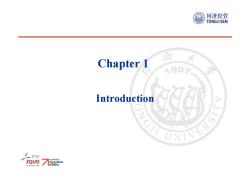
同济经管 TONGJI SEM Chapter 1 490 Introduction EOUIS
Chapter 1 Introduction
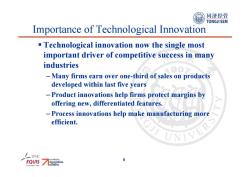
同济经管 TONGJI SEM Importance of Technological Innovation Technological innovation now the single most important driver of competitive success in many industries -Many firms earn over one-third of sales on products developed within last five years -Product innovations help firms protect margins by offering new,differentiated features. -Process innovations help make manufacturing more efficient. EFMC EQUIS 6
6 Importance of Technological Innovation Technological innovation now the single most important driver of competitive success in many industries – Many firms earn over one-third of sales on products developed within last five years – Product innovations help firms protect margins by offering new, differentiated features. – Process innovations help make manufacturing more efficient
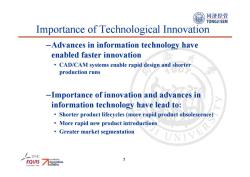
同济经管 TONGJI SEM Importance of Technological Innovation -Advances in information technology have enabled faster innovation CAD/CAM systems enable rapid design and shorter production runs -Importance of innovation and advances in information technology have lead to: Shorter product lifecycles(more rapid product obsolescence) More rapid new product introductions Greater market segmentation EQUIS
7 Importance of Technological Innovation –Advances in information technology have enabled faster innovation • CAD/CAM systems enable rapid design and shorter production runs –Importance of innovation and advances in information technology have lead to: • Shorter product lifecycles (more rapid product obsolescence) • More rapid new product introductions • Greater market segmentation
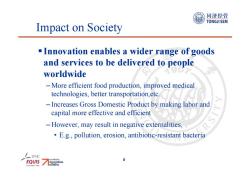
同济经管 TONGJI SEM Impact on Society -Innovation enables a wider range of goods and services to be delivered to people worldwide -More efficient food production,improved medical technologies,better transportation,etc. -Increases Gross Domestic Product by making labor and capital more effective and efficient -However,may result in negative externalities. E.g.,pollution,erosion,antibiotic-resistant bacteria EQUIS 8
8 Impact on Society Innovation enables a wider range of goods and services to be delivered to people worldwide – More efficient food production, improved medical technologies, better transportation,etc. – Increases Gross Domestic Product by making labor and capital more effective and efficient – However, may result in negative externalities, • E.g., pollution, erosion, antibiotic-resistant bacteria
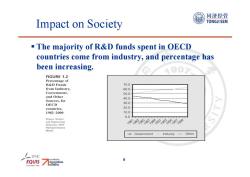
同济经管 Impact on Society TONGJI SEM The majority of R&D funds spent in OECD countries come from industry,and percentage has been increasing. A90> FIGURE 1.2 Percentage of R&D Funds 70.0 from Industry 60.0 Government, 50.0 and Other 40.0 Sources,for OECD 30.0 countries. 20.0 1982-2000 10.0 0.0 Source:Science g的ocs的s9 Board. Government Industry- Other 9 EOUIS
9 Impact on Society The majority of R&D funds spent in OECD countries come from industry, and percentage has been increasing

Innovation by Industry: 同济经管 TONGJI SEM The Importance of Strategy Successful innovation requires carefully crafted strategies and implementation processes. Innovation funnel Most innovative ideas do not become successful new products. FIGURE 1.3 The Innovation Funnel 3,000Raw 300 Developments 2 Launches 4 Major 1 Successful New Product ERS EOUIS 10
10 Innovation by Industry: The Importance of Strategy Successful innovation requires carefully crafted strategies and implementation processes. Innovation funnel – Most innovative ideas do not become successful new products
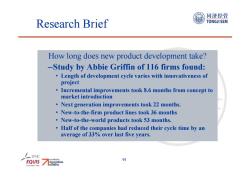
同济经管 Research Brief TONGJI SEM How long does new product development take? -Study by Abbie Griffin of 116 firms found: Length of development cycle varies with innovativeness of project Incremental improvements took 8.6 months from concept to market introduction Next generation improvements took 22 months. New-to-the-firm product lines took 36 months New-to-the-world products took 53 months. Half of the companies had reduced their cycle time by an average of 33%over last five years. EQUIS 11
11 How long does new product development take? –Study by Abbie Griffin of 116 firms found: • Length of development cycle varies with innovativeness of project • Incremental improvements took 8.6 months from concept to market introduction • Next generation improvements took 22 months. • New-to-the-firm product lines took 36 months • New-to-the-world products took 53 months. • Half of the companies had reduced their cycle time by an average of 33% over last five years. Research Brief
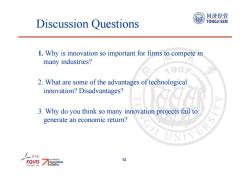
同济经管 Discussion Questions TONGJI SEM 1.Why is innovation so important for firms to compete in many industries? A90 2.What are some of the advantages of technological innovation?Disadvantages? 3.Why do you think so many innovation projects fail to generate an economic return? EFMC EQUIS 12
12 Discussion Questions 1. Why is innovation so important for firms to compete in many industries? 2. What are some of the advantages of technological innovation? Disadvantages? 3. Why do you think so many innovation projects fail to generate an economic return?

Industry Dynamics of Technological 同济经管 TONGJI SEM Innovation The sources from which innovation arises,including the role of individuals,organizations,government institutions,and networks, A8 Types of innovations,and common industry patterns of technological evolution and diffusion, The factors that determine whether industries experience pressure to select a dominant design,and what drives which technologies dominate others, Effects of timing of entry,and how firms can identify (and manage)their entry options. EFMC EQUIS 13
13 Industry Dynamics of Technological Innovation The sources from which innovation arises, including the role of individuals, organizations, government institutions, and networks, Types of innovations, and common industry patterns of technological evolution and diffusion, The factors that determine whether industries experience pressure to select a dominant design, and what drives which technologies dominate others, Effects of timing of entry, and how firms can identify (and manage) their entry options
按次数下载不扣除下载券;
注册用户24小时内重复下载只扣除一次;
顺序:VIP每日次数-->可用次数-->下载券;
- 《管理运筹学》课程教学资源(课件讲义)第九章 图与网络模型.pdf
- 《管理运筹学》课程教学资源(课件讲义)第八章 目标规划.pdf
- 《管理运筹学》课程教学资源(课件讲义)第七章 整数规划.pdf
- 《管理运筹学》课程教学资源(课件讲义)第六章 运输问题.pdf
- 《管理运筹学》课程教学资源(课件讲义)第五章 单纯形法的灵敏度分析与对偶.pdf
- 《管理运筹学》课程教学资源(课件讲义)第四章 单纯形法.pdf
- 《管理运筹学》课程教学资源(课件讲义)第三章 线性规划在工商管理中的应用.pdf
- 《管理运筹学》课程教学资源(课件讲义)第二章 线性规划图解法.pdf
- 《管理运筹学》课程教学资源(课件讲义)第一章 绪论 Operational Research.pdf
- 《管理运筹学》课程教学资源(课件讲义)第十章 存储论.pdf
- 安徽科技学院:《物流管理》课程教学课件(生产与运作管理)第四章 生产服务设施选址与布置.pdf
- 安徽科技学院:《物流管理》课程教学课件(生产与运作管理)第六章 生产技术准备.pdf
- 安徽科技学院:《物流管理》课程教学课件(生产与运作管理)第八章 生产计划.pdf
- 安徽科技学院:《物流管理》课程教学课件(生产与运作管理)第五章 企业生产过程组织(Organization of Production Procedure).pdf
- 安徽科技学院:《物流管理》课程教学课件(生产与运作管理)第二章 生产与运作战略.pdf
- 安徽科技学院:《物流管理》课程教学课件(生产与运作管理)第九章 生产现场管理.pdf
- 安徽科技学院:《物流管理》课程教学课件(生产与运作管理)第三章 产品开发与工艺选择.pdf
- 安徽科技学院:《物流管理》课程教学课件(生产与运作管理)第七章 生产作业计划.pdf
- 安徽科技学院:《物流管理》课程教学课件(生产与运作管理)第一章 导论.pdf
- 安徽科技学院:《物流管理》课程教学课件(采购与仓储管理)第09章 采购合同履行.pdf
- 同济大学:《技术创新管理》课程教学资源(电子教案)MANAGEMENT OF TECHNOLOGICAL INNOVATION(2/2,负责人:陈松).pdf
- 吉林大学:《现代企业管理》课程电子教案(PPT课件)总复习(负责人:王丽杰).ppt
- 吉林大学:《现代企业管理》课程电子教案(PPT课件)第一章 企业与企业管理.ppt
- 吉林大学:《现代企业管理》课程电子教案(PPT课件)第七章 质量管理(负责人:王丽杰).ppt
- 吉林大学:《现代企业管理》课程电子教案(PPT课件)第三章 企业管理环境.ppt
- 吉林大学:《现代企业管理》课程电子教案(PPT课件)第二章 管理与企业管理.ppt
- 吉林大学:《现代企业管理》课程电子教案(PPT课件)第五章 企业经营决策方法.ppt
- 吉林大学:《现代企业管理》课程电子教案(PPT课件)第八章 企业物流与设备管理.ppt
- 吉林大学:《现代企业管理》课程电子教案(PPT课件)第六章 生产管理概论.ppt
- 吉林大学:《现代企业管理》课程电子教案(PPT课件)第四章 企业经营思想与战略.ppt
- 吉林大学:《企业资源规划》课程电子教案(PPT课件)第1章 概述(主讲:梅芳).ppt
- 吉林大学:《企业资源规划》课程电子教案(PPT课件)第2章 企业资源和基础数据.ppt
- 吉林大学:《企业资源规划》课程电子教案(PPT课件)第3章 主生产计划(Master Production Schedule,MPS).ppt
- 吉林大学:《企业资源规划》课程电子教案(PPT课件)第4章 物料需求计划.ppt
- 吉林大学:《企业资源规划》课程电子教案(PPT课件)第5章 能力需求计划(Capacity Requirements Planning, CRP).ppt
- 吉林大学:《企业资源规划》课程电子教案(PPT课件)第6章 采购作业计划和控制.ppt
- 吉林大学:《企业资源规划》课程电子教案(PPT课件)第7章 生产作业计划和管理.ppt
- 吉林大学:《企业资源规划》课程电子教案(PPT课件)第8章 ERP系统的主要功能.ppt
- 《市场营销学》课程教学资源(题库)课程各章练习题(共九部分,含参考答案).pdf
- 中央民族大学:《新青年全球胜任力人才培养项目》课程教学大纲(2022秋).pdf
